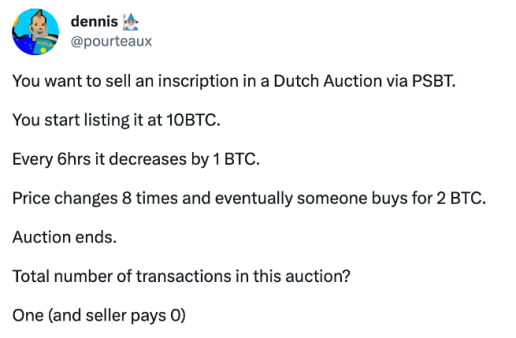The Bitcoin ecosystem has been reinvigorated since the introduction of the Bitcoin Ordinals project. Now, builders continue to work tirelessly to support the surging Bitcoin Ordinals demand by adding features to wallets and creating marketplaces.
Speaking of developments, a new case study has emerged in recent weeks that could change how users buy and sell their Bitcoin Ordinal NFT inscriptions: a PBST Dutch auction.
Before diving into what a PSBT Dutch Auction is and its implication for Bitcoin Ordinals, it's essential to break down its concepts and how they work together.
What is a PBST Dutch Auction?
A PBST Dutch Auction derives from a traditional Dutch Auction that utilizes PSBTs.
Okay, so what is a PSBT and how does it work?
A Partially Signed Bitcoin Transaction (PSBT) is a Bitcoin core transaction format released in 2017 with BIP 174. PSBT V2 was released with BIP 370 allowing the addition of inputs and outputs to be added after PSBT creation.
PSBTs enable the creation of unsigned or partially signed transactions to be exchanged with multiple signers. PSBTs improve how various wallets (e.g., software, hardware, multisig, etc.) communicate and enable users to perform and sign offline transactions without making any bitcoin state changes.
The usage of PSBTs simplify the coordination between multiple parties who require a signed transaction at different times. Once all transaction signatures are made, the PSBT is converted to a ready-to-broadcast transaction and broadcasted to a bitcoin node. This transaction format creates the ideal infrastructure for a trustless transaction (auction) between two parties using BTC as the underlying currency.
A Dutch Auction, also known as a descending price auction, dates back to early 1600s Holland when tulip bulbs were first introduced to the market. Due to the wild speculation and inefficient trading practices, the Dutch Auction was born.
Dutch Auctions follow a standard process where the seller (auctioneer) publicly sets a starting price, the time interval, and the price increments (descending price tick) within each time interval before the start of the Auction. Because this auction method declines in price over time, sellers are incentivized to set the auction price at the highest range they believe is attainable.
The Auction starts at the seller’s preset price and declines by the set price increment at each predetermined time interval until a successful bid is received. The Auction ends once a winning bid is made.
How does a PSBT Dutch Auction using BTC work with Ordinals?
By merging the mechanics of a Dutch Auction and implementing PSBTs, a seller can facilitate a PSBT auction with Ordinals manually or by writing a script to automate the Auction. The selling party of a PSBT auction publicly sets the parameters for their Dutch Auction.
The clock starts at the initially set price. At each time interval, the seller signs the PSBT, which triggers each descending price tick. The winning bidder effectively signs the final transaction, sending the bid amount net of transaction fees to the seller.
Possibly the first PSBT Dutch Auction was held by @pourteaux in February 2023. He performed the Auction manually using Google sheets with his Color Study 10/10 Collection. It required a simple bitcoin transaction with 4 inputs and 3 outputs.

Dennis Pourteaux explains how a PSBT Dutch Auction would work for Bitcoin Ordinals inscriptions
What Makes a PSBT Dutch Auction So Attractive?
Over the last year, crypto’s ethos, “not your keys, not your coins” was highly emphasized as thousands of users experienced lost custody of their assets on select exchanges. The most significant benefit of a PSBT auction is the ability to have a trustless auction without an intermediary. This is starkly different from other NFT auctions held on Ethereum and other chains. Examples of other benefits include the following:
- Zero trust assumptions and counterparty risk
- Free of listing, bidding, or selling fees
- Private or public PSBTs based on preference
- Requires no bandwidth or bitcoin state updates
- No “gas wars”
However, the downsides of a PSBT Dutch Auction do exist.
Using PSBTs requires a technically savvy bitcoin user to participate in a PSBT auction. This learning curve does create a barrier to entry for both the seller and buyer, which could limit participants. Also, due to the nature of a Dutch Auction, a buyer pays the maximum of what they were willing to pay.
Why is the crypto community excited about PSBT Dutch Auctions and Bitcoin inscriptions?
In just a few months, the Ordinals marketplace has grown to over 13k unique users with over $9 million in trading volume. There have been nearly 450k Inscriptions to date paying $1.8 million in fees to Bitcoin miners.
Needless to say: people want Ordinal inscriptions. This traction has forced builders into overdrive to quickly iterate on wallet and marketplace support.
The excitement around Bitcoin NFTs fueled by Bitcoin Ordinals and inscriptions attracted the attention of NFT juggernauts like Yuga Labs, announcing their first Bitcoin collection, TwelveFold. Although there has been widespread criticism of the team at Yuga Labs’ permissioned auction approach, their entry into the Bitcoin ecosystem sends a strong signal across the entire crypto community.
In addition to Yuga Labs’ announcement, Galaxy Digital’s recent Bitcoin Inscriptions and Ordinals report, claims the Ordinals market could become a new $5 billion market while bringing meaningful transaction fee volume to miners and delaying any concerns of the impact on Bitcoin’s security budget.
Are PSBTs the future of NFT auctions in Web3?
If Web3 is striving for a decentralized economy and PSBT Dutch Auctions are trustless, it seems rational that PSBTs will become more accepted and be a driver of demand for Ordinals.
Builders will continue to focus on the development of PSBT compatibility to meet the needs of users.
During a prolonged bear market where countless smart contract exploits have occurred, it's refreshing to see a secure, non-custodial solution for the NFT marketplace while bringing attention and new users to the Bitcoin ecosystem.

